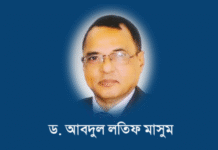When does development equal freedom?
We need to take a step back and analyse Bangladesh’s development approach through the lens of freedom

In the more than four decades since independence, Bangladesh has made remarkable strides on many fronts. It is no longer the “basket case” as Henry Kissinger, former US secretary of state, had dismissively remarked about the newborn country in 1971. Not only has Bangladesh defiantly shed this label but is also looked upon as an emerging economy to watch out for. The country today provides for a puzzling case study of developmental success in political and academic circles the world over.
Bangladesh’s achievements in areas such as child and maternal health, increased access to education, reduction in poverty, and of course economic growth cannot be overlooked. More children are going to school, and more women today are financially independent than ever before. The important work being done by both NGOs and governmental organisations in rural areas has had a crucial role to play in much of the empowerment of women we take so much pride in (and rightfully so). Family planning interventions gave rural women decision-making power, and the microfinance revolution of the late 90s busted the myth that banking is only for the privileged. One wonders what Kissinger would have to say now.
However, as “development” takes centre stage in our national policies and discourse, the pathway of the country’s development in more recent times has received its fair share of criticism from economists, policymakers, journalists and researchers alike. From the environmental threat of mega projects like Rampal and Rooppur to their financial viability (massive foreign loans at high cost) and scepticism about benefits to the people of the country (whether or not electricity at a lower cost will in fact be achieved), experts have consistently expressed their inhibitions about the consequences of these development projects, but in vain. With mega projects such as the metro rail, Payra sea port, Matarbari, etc., increasingly in the public eye, there is a common misconception that development or unnayan has become synonymous with road or energy infrastructure. But “development” is much more than that.
One of the fundamentals of a country’s development trajectory is its development approach undergirding the national policies and commitments, budgets, etc. It is this very approach that provides the basis for the “nature” of development taking place and this is what dictates how resources will be allocated, who/what will be prioritised, and whether or not “people-centric development” is being pursued.
To understand what development approach means, it is important to know that the concept of “development” is dynamic—it has evolved over time with theories put forward by different economists since the 1950s. Early development economists first equated development with growth per capita income and the definition of development was later expanded to include the fulfilment of basic needs.
But one of the most profound explanations of development was put forward by Amartya Sen, the first Asian to win the Nobel Prize in Economics, who went much further than his predecessors to theorise that development is that which entails personal and political freedoms and the capability of individuals to lead the kind of lives they have “reason to value”. And thus, poverty is understood as the lack of capability to lead a good life and “development” would mean enhancing this very capability to exercise one’s economic and political choices, among other things. To put it simply, Sen’s thesis is that “freedom is both the primary end and the principal means of development.” This very short summary, of course, does not capture the depth of Sen’s groundbreaking philosophy in the field of development economics but suffice it to say that in his view, growth in GDP, rise in incomes and technological advancement are simply a means to achieve the most basic freedoms—and not an end in itself.
Even two decades after Amartya Sen’s highly acclaimed book Development as Freedom was published, his singular vision of capturing the essence of development through the lens of individual freedoms of the people remains as relevant and important as ever for developing countries like Bangladesh. It begs the questions: Is our development trajectory driven by a narrow view of boosting GDP or personal incomes? Or is our development approach rooted in the ultimate goal of expanding the freedoms of all citizens? Is GDP growth or technological progress simply an end in itself or does it have an overarching objective of removing the “unfreedoms” (as Sen calls them) such as poverty, obstacles to civil liberties, intolerance and systematic social deprivation?
With so much emphasis on “seven-plus GDP growth,” one may be forgiven for thinking that GDP is the holy grail of development. But according to Sen’s theory, GDP growth or income is not necessarily a good indicator of wellbeing. For instance, he cited the example of Sri Lanka which in 1980 had a higher life expectancy at birth than that of South Korea, although the latter’s income per capita was five times higher. This, however, does not mean that economic growth is not important; it is vital only insofar as other non-material benefits are realised in the process of achieving economic growth.
Bangladesh’s development pathway, at least on paper, is far from GDP-centric. The government has shown its commitment towards undertaking an inclusive development approach through its ambitious Seventh Five Year Plan which was developed in the spirit of the Sustainable Development Goals. The objectives of the 7FYP (whose theme is “accelerating growth, empowering citizens”) go to show that ours is not a parochial view of development that focuses on material benefits alone. But when it comes to translating the objectives of the 7FYP into concrete results—such as making available safe drinking water for all urban and rural populations or targeting expenditure of 2.84 percent of GDP on education (FY2018–19 budgetary allocation of education already falls short of this target) or providing quality education to equip the future generation with critical thinking skills—which is arguably the first step towards giving people the opportunities to realise their freedoms, we still lag behind. “Social opportunities” (arrangements for healthcare, education, etc) are a component of Sen’s definition of freedom.
One of the criticisms of Sen’s approach was that he did not exactly touch upon how one would measure the progress made in achieving freedom. But “transparency guarantees”—another crucial ingredient in Sen’s understanding of what freedom entails—mean “interactions with others, including the government, characterised by a mutual understanding of what is offered and what to expect.” So one could argue that elements such as rule of law and corruption greatly impact a people’s political and economic freedoms.
At a time when Bangladesh is on the verge of graduating out of the LDC category, our policymakers and political elites ought to ask themselves some hard questions. Does our development approach that promises to provide quality education and healthcare go beyond agreements and commitments signed on paper? Is ours a development approach that is humanistic—one that paves the way for the majority to exercise free agency in all spheres of life? Does it aim to maximise people’s political and economic freedoms?
Epictetus, the Greek philosopher, had observed: “Is freedom anything else than the right to live as we wish? Nothing else.”
Nahela Nowshin is a member of the editorial team at The Daily Star.
Source: The Daily Star.










As GDP is flashed as growing, price rise is disproportionate to income rise, fall in income or its inadequacy pushes down people below their buying capacity.This ground reality is felt by those who are suffering though their voice is muffled by strict repressive law. Hence economists cannot reach this truth in their lengthy analytical reports.This in human GDP-centric development development is an antithesis of Amartya Sen’s thesis on “freedom is both the primary end and the principal means of development.” as written in his ‘Development as freedom’. Fortunately, our people do not understand the impact of budget and our economist are fond of lengthy complex analysis which cannot reach the people. They only feel that budget increases cost without proportionate increase in income.